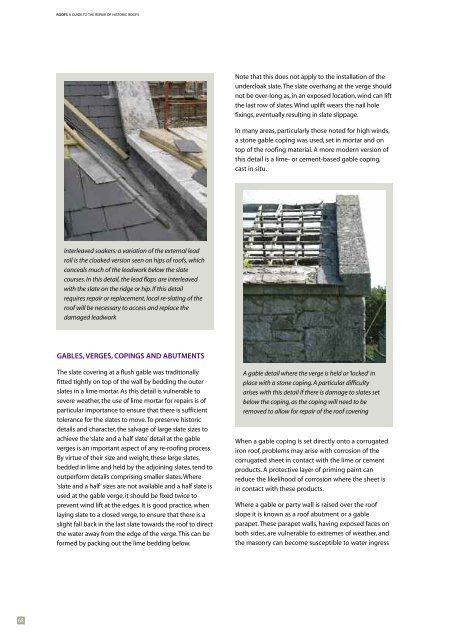ROOFS A GUIDE TO THE REPAIR OF HISTORIC ROOFSSNOW BOARDS AND ACCESS BOARDSSnow or access boards are sometimes found in hiddengutters. These running boards are laid in both valleyand parapet gutters and are like gangways orduckboards on a boat. They are typically constructed<strong>of</strong> good quality s<strong>of</strong>twood as hardwood tends <strong>to</strong> beslippery when wet. Modern materials may providealternative, longer-lasting solutions depending on <strong>the</strong>situation. The primary function <strong>of</strong> snow and accessboards is <strong>to</strong> allow blown debris <strong>to</strong> remain on <strong>to</strong>p <strong>of</strong><strong>the</strong> boards whilst not impeding <strong>the</strong> water flowingunderneath, but <strong>the</strong>y also afford a level <strong>of</strong> protection<strong>to</strong> <strong>the</strong> ro<strong>of</strong> covering, preventing puncturing frompedestrian traffic.After heavy falls <strong>of</strong> snow, when <strong>the</strong> depth <strong>of</strong> snow islikely <strong>to</strong> exceed <strong>the</strong> height <strong>of</strong> <strong>the</strong> sides <strong>of</strong> <strong>the</strong> gutterlinings, snow boards allow <strong>the</strong> melt water <strong>to</strong> flow awayfreely beneath <strong>the</strong> accumulated snow. In most areas <strong>of</strong>Ireland, a properly detailed tapered valley or parapetgutter will rarely experience problematic snow andmeltwater levels. However, where snow conditions areknown <strong>to</strong> be severe, access is difficult or <strong>the</strong> buildingfabric or contents are particularly valuable, proprietaryelectric heating tapes laid in <strong>the</strong> gutters, catch pits andhopper heads can be considered as an alternative, oran addition, <strong>to</strong> snow boards.Snow and access boards need <strong>to</strong> be maintained as<strong>the</strong>y can frequently trap debris, and if allowed <strong>to</strong>deteriorate can end up blocking <strong>the</strong> gutters andrainwater outlets <strong>the</strong>y were meant <strong>to</strong> protect. It shouldbe noted that <strong>the</strong>y can constitute a significant trip orfall hazard at ro<strong>of</strong> level, particularly when <strong>the</strong>y are inpoor condition.RIDGES AND HIPSA missing ridge cap allows <strong>the</strong> penetration <strong>of</strong> waterin<strong>to</strong> <strong>the</strong> ro<strong>of</strong> at a very vulnerable point. Replacementsare generally available for his<strong>to</strong>ric clay ridge tiles,though care should be taken, as <strong>the</strong> angle <strong>of</strong> eachridge cap may vary and <strong>the</strong> colour or glazing maydiffer. Where <strong>the</strong>re are no equivalent modern versionsin production, some companies may be able <strong>to</strong> matchunusual pr<strong>of</strong>iles. Clay ridge tiles should be bedded inlime mortar and a consistent ridge line formed bytight, well pointed-up joints. The ridge and hip tilesshould not be fitted with wide joints in order <strong>to</strong> avoidmaking up a shortfall <strong>of</strong> salvaged tiles. This is a falseeconomy as it results in fat, highly visible and morevulnerable mortar joints.Incorrect bedding and detailing, with fat joints <strong>to</strong> <strong>the</strong>ridge and hip tiles, are visually very disruptive andinappropriate <strong>to</strong> a his<strong>to</strong>ric buildingOn hipped ro<strong>of</strong>s, <strong>to</strong> reduce <strong>the</strong> impact <strong>of</strong> <strong>the</strong> weight <strong>of</strong><strong>the</strong> clay hip tiles and <strong>to</strong> prevent <strong>the</strong>m slipping down<strong>the</strong> ro<strong>of</strong>, a decorative wrought-iron strap known as ahip iron was sometimes fixed <strong>to</strong> <strong>the</strong> <strong>to</strong>p <strong>of</strong> <strong>the</strong> hiprafter <strong>to</strong> support <strong>the</strong> lowest tile. Less decorative strapswere concealed in <strong>the</strong> bedding for <strong>the</strong> ridge s<strong>to</strong>ne orhip tile at eaves level. Where <strong>the</strong> irons have corroded,<strong>the</strong> hip ridge tiles can start <strong>to</strong> move, creating gaps andallowing water penetration. This movement eventuallyresults in <strong>the</strong> hip tile falling <strong>of</strong>f <strong>the</strong> ro<strong>of</strong>. Pig tail hipirons (so called because <strong>of</strong> <strong>the</strong>ir decorative shape) arecommonly available but should not be used for repairsunless <strong>the</strong>re is a his<strong>to</strong>ric precedent for <strong>the</strong> design. Aplain, buried fixing should be used instead. In mostcases, provided <strong>the</strong> hip and ridge tiles have not beenpreviously fixed with concrete, it should be possible <strong>to</strong>remove <strong>the</strong> tiles without damage <strong>to</strong> <strong>the</strong> underlyingslate. The hip irons can be fixed directly <strong>to</strong> <strong>the</strong> rafterprovided that <strong>the</strong> underlying timber is in soundcondition. Where a lead ridge or hip roll has slipped or<strong>to</strong>rn, <strong>the</strong> replacement should follow <strong>the</strong> detailillustrated here.Additionalfixings whichoccur under<strong>the</strong> leadThe Lead Sheet Association advises a modification <strong>to</strong><strong>the</strong> pr<strong>of</strong>ile <strong>of</strong> <strong>the</strong> ‘broom handle’ timber roll andpromotes instead <strong>the</strong> use <strong>of</strong> a more elongatedsection in treated s<strong>of</strong>twood <strong>to</strong> reduce <strong>the</strong> likelihood<strong>of</strong> <strong>the</strong> pinched lead cracking along <strong>the</strong> roll67
ROOFS A GUIDE TO THE REPAIR OF HISTORIC ROOFSNote that this does not apply <strong>to</strong> <strong>the</strong> installation <strong>of</strong> <strong>the</strong>undercloak slate. The slate overhang at <strong>the</strong> verge shouldnot be over-long as, in an exposed location, wind can lift<strong>the</strong> last row <strong>of</strong> slates. Wind uplift wears <strong>the</strong> nail holefixings, eventually resulting in slate slippage.In many areas, particularly those noted for high winds,a s<strong>to</strong>ne gable coping was used, set in mortar and on<strong>to</strong>p <strong>of</strong> <strong>the</strong> ro<strong>of</strong>ing material. A more modern version <strong>of</strong>this detail is a lime- or cement-based gable coping,cast in situ.Interleaved soakers: a variation <strong>of</strong> <strong>the</strong> external leadroll is <strong>the</strong> cloaked version seen on hips <strong>of</strong> ro<strong>of</strong>s, whichconceals much <strong>of</strong> <strong>the</strong> leadwork below <strong>the</strong> slatecourses. In this detail, <strong>the</strong> lead flaps are interleavedwith <strong>the</strong> slate on <strong>the</strong> ridge or hip. If this detailrequires repair or replacement, local re-slating <strong>of</strong> <strong>the</strong>ro<strong>of</strong> will be necessary <strong>to</strong> access and replace <strong>the</strong>damaged leadworkGABLES, VERGES, COPINGS AND ABUTMENTSThe slate covering at a flush gable was traditionallyfitted tightly on <strong>to</strong>p <strong>of</strong> <strong>the</strong> wall by bedding <strong>the</strong> outerslates in a lime mortar. As this detail is vulnerable <strong>to</strong>severe wea<strong>the</strong>r, <strong>the</strong> use <strong>of</strong> lime mortar for repairs is <strong>of</strong>particular importance <strong>to</strong> ensure that <strong>the</strong>re is sufficient<strong>to</strong>lerance for <strong>the</strong> slates <strong>to</strong> move. To preserve his<strong>to</strong>ricdetails and character, <strong>the</strong> salvage <strong>of</strong> large slate sizes <strong>to</strong>achieve <strong>the</strong> ‘slate and a half slate’ detail at <strong>the</strong> gableverges is an important aspect <strong>of</strong> any re-ro<strong>of</strong>ing process.By virtue <strong>of</strong> <strong>the</strong>ir size and weight, <strong>the</strong>se large slates,bedded in lime and held by <strong>the</strong> adjoining slates, tend <strong>to</strong>outperform details comprising smaller slates. Where‘slate and a half’ sizes are not available and a half slate isused at <strong>the</strong> gable verge, it should be fixed twice <strong>to</strong>prevent wind lift at <strong>the</strong> edges. It is good practice, whenlaying slate <strong>to</strong> a closed verge, <strong>to</strong> ensure that <strong>the</strong>re is aslight fall back in <strong>the</strong> last slate <strong>to</strong>wards <strong>the</strong> ro<strong>of</strong> <strong>to</strong> direct<strong>the</strong> water away from <strong>the</strong> edge <strong>of</strong> <strong>the</strong> verge. This can beformed by packing out <strong>the</strong> lime bedding below.A gable detail where <strong>the</strong> verge is held or ‘locked’ inplace with a s<strong>to</strong>ne coping. A particular difficultyarises with this detail if <strong>the</strong>re is damage <strong>to</strong> slates setbelow <strong>the</strong> coping, as <strong>the</strong> coping will need <strong>to</strong> beremoved <strong>to</strong> allow for repair <strong>of</strong> <strong>the</strong> ro<strong>of</strong> coveringWhen a gable coping is set directly on<strong>to</strong> a corrugatediron ro<strong>of</strong>, problems may arise with corrosion <strong>of</strong> <strong>the</strong>corrugated sheet in contact with <strong>the</strong> lime or cementproducts. A protective layer <strong>of</strong> priming paint canreduce <strong>the</strong> likelihood <strong>of</strong> corrosion where <strong>the</strong> sheet isin contact with <strong>the</strong>se products.Where a gable or party wall is raised over <strong>the</strong> ro<strong>of</strong>slope it is known as a ro<strong>of</strong> abutment or a gableparapet. These parapet walls, having exposed faces onboth sides, are vulnerable <strong>to</strong> extremes <strong>of</strong> wea<strong>the</strong>r, and<strong>the</strong> masonry can become susceptible <strong>to</strong> water ingress68
















